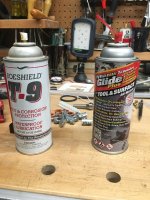From my experience, cast iron rusts mainly due to condensation. If you heat the room just when you work there, then the cast iron remains colder than the rest of the room and is ripe for condensation, and then for rust.
Running a dehumidifier will help.
There are also anti-condensation warmers. These are usually used in enclosed spaces like toolboxes, gun safes, etc. But placed under a cast iron surface, it can work well too.
I am not certain of the exact term to google for those devices. But my search shows many options:
https://www.google.com/search?q=anti-condenstion warmer&ie=utf-8&oe=utf-8&client=firefox-b-1-m
As an amusing side bar, the company I used to work for made metal parts and we often would ship full (44,0000 pound) loads. Our customer arranged the shipment and the truck arrived with a “refer” trailer (refrigerator trailer).
This is fine as long as the driver did not turn on the refrigeration unit.
But that was not what he did.
It travelled from Yonkers, New York, to Plant City, Florida. Our galvanized bails looked fine coming out of the truck, however moisture quickly condensed on the surfaces and by morning, most of the product suffered from “white rust” (zinc oxide).
I don’t know how this was resolved. It was between the trucker and our customer. We only supplied expert evaluation as to how the problem occurred.
My shop is in the basement and I never heat or cool the basement. I have a dehumidifier that I run occasionally. I don’t have a rust problem in my shop, though some very old nails and screws are rusted. Most iron castings have some graphite in the casting and it offers a moderate amount of corrosion protection. But mostly I think wood polishes off any incipient corrosion before it is really visible.

